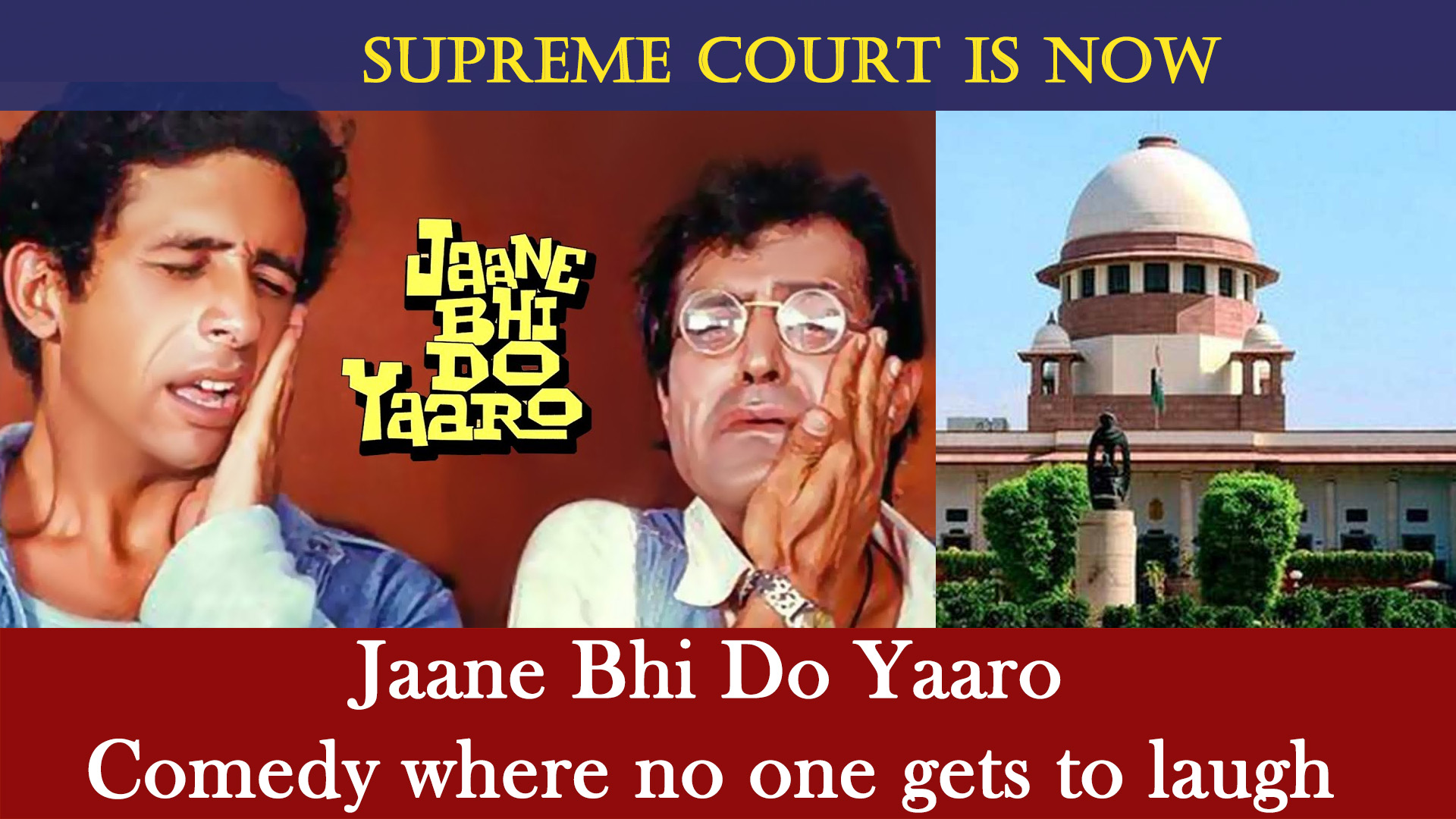Picture this: a court so mighty it can tell Parliament to take a hike, delay justice for centuries, and protect its judges even when their houses are stuffed with burnt cash! Welcome to the Supreme Court of India, where the drama unfolds like a scene from the 1983 Bollywood classic Jaane Bhi Do Yaaro. In this hilarious yet maddening tale, two cases—Kesavananda Bharati (1973) and K. Veeraswami (1991)—turned the Supreme Court into an untouchable superhero, leaving the common man scratching his head like Vinod and Sudhir, the bumbling photographers from the movie. From stalling the Ram Mandir case to rushing Waqf hearings and dodging a cash-burning scandal, the Supreme Court’s antics would make even Jaane Bhi Do Yaaro’s corrupt builder Tarneja blush. Grab some popcorn, folks, as we unravel this comedy of errors for every chai-wala and auto-driver to understand!
Kesavananda Bharati: When Judges Snatched the Script
Back in 1973, a Kerala priest named Kesavananda Bharati walked into the Supreme Court, upset about a land law. Sounds simple, right? Wrong! It was like Jaane Bhi Do Yaaro’s plot—small issue, massive chaos! The real fight was about who runs the show: Parliament (the people’s elected gang) or the Supreme Court (the black-robed bosses). Parliament thought it could rewrite the Constitution like a Bollywood script, but the judges said, “Arre, not so fast!”
Thirteen judges, looking like a courtroom cricket team, sat down to decide. In a nail-biting 7-6 finish, they invented the Basic Structure Doctrine—a fancy term meaning some parts of the Constitution are untouchable, like the hero’s love story in a masala movie. Guess what’s untouchable? The Supreme Court’s own power, independence, and right to say “No!” to Parliament’s laws.
What’s the Joke?
- Parliament Got Demoted: Before 1973, Parliament was the director, changing the Constitution as it pleased. After Kesavananda, the Supreme Court grabbed the megaphone, saying, “We’ll decide what’s allowed!” It’s like Vinod and Sudhir stumbling into Tarneja’s office and declaring themselves builders!
- Judges Became Superheroes: The Supreme Court made itself part of the “basic structure,” meaning no one can mess with its powers. It’s as if the judges put on capes and said, “We’re above everyone—deal with it!”
- Common Man Left Confused: While the judges celebrated, the aam aadmi was left wondering, “Who’s running this country—my MP or these wig-wearing uncles?”
Kesavananda Bharati turned the Supreme Court into a Bollywood villain with a heart of gold—powerful, untouchable, and always stealing the show. But like Tarneja’s shady deals, this power grab came at a cost.
K. Veeraswami: The “Don’t Touch the Judge” Rule
Fast-forward to 1991, and we get another Jaane Bhi Do Yaaro-style twist in the K. Veeraswami case. K. Veeraswami, a former High Court Chief Justice, was caught in a corruption mess. The question was: Can you arrest a judge for crimes like taking bribes, or are they as untouchable as the Supreme Court’s ego?
The Supreme Court, like a protective big brother, said, “Sure, you can file a case against a judge… but only if the Chief Justice says okay!” This rule, born in the Veeraswami case, means no police can knock on a judge’s door without the Chief Justice’s thumbs-up. It’s like needing the villain’s permission to catch the villain!
Why’s This Funny (and Sad)?
Judges Guarding Judges: Imagine Tarneja telling Vinod and Sudhir, “You can investigate me, but only if I say so!” That’s the Veeraswami rule—judges decide if judges get in trouble. No wonder the common man feels like he’s stuck in a comedy sketch!
The Burnt Cash Fiasco: In March 2025, a fire broke out at Delhi High Court judge Justice Yashwant Varma’s bungalow. The fire brigade, expecting smoke, found sacks of burnt cash—crores of rupees turned to ashes! Was it bribe money? A barbecue gone wrong? Nobody knows, because the Veeraswami rule means no FIR without the Chief Justice’s nod. It’s like Tarneja’s goons burning evidence while everyone watches, helpless!
Justice Delayed, Trust Burned: The aam aadmi, who can’t afford a dosa, wonders why a judge with burnt cash gets a free pass while regular folks get jailed for stealing a loaf of bread. This rule makes the Supreme Court look like a club where members cover for each other, laughing all the way to the bank.
The Veeraswami case is the Supreme Court’s version of Jaane Bhi Do Yaaro’s infamous bridge collapse scene—everything’s falling apart, but the big shots walk away grinning.
The Supreme Court’s Biased Play: Ram Mandir vs. Waqf
With all this power from Kesavananda Bharati and protection from Veeraswami, the Supreme Court runs the show like a biased film director. Hindu cases? They’re stuck in the editing room for decades. Waqf cases? They get a red-carpet premiere! It’s a comedy of errors, but the joke’s on us.
Ram Mandir: The Never-Ending Movie
The Ram Mandir case in Ayodhya was like a 100-year-long Bollywood saga—full of drama but no climax. For Hindus, it wasn’t just a court case; it was about faith and history. Yet, the Supreme Court played it like a lazy editor, delaying hearings for decades. The verdict finally came in 2019, but only after years of “Next date, please!” Other Hindu cases, like temple rights or festival disputes, also crawl slower than a Jaane Bhi Do Yaaro scooter chase. The common man feels cheated, wondering if the Supreme Court’s saving its energy for someone else.
Waqf Cases: The VIP Premiere
Meanwhile, Waqf cases—disputes over Muslim religious properties—get the Supreme Court’s VIP treatment. Need a hearing? Boom, urgent date! Property claim? Front of the line! It’s like the court’s rolling out the red carpet for one hero while leaving the other in the background. This bias makes people think the Supreme Court’s got a soft spot for leftists and Muslims, leaving Hindus stuck in the queue like Vinod and Sudhir waiting for Tarneja’s payment.
The Punchline
Thanks to Kesavananda Bharati, the Supreme Court can pick its favorites without anyone saying, “Cut!” Its judges, shielded by Veeraswami, don’t have to explain why Ram Mandir waited forever while Waqf cases zoomed ahead. It’s a courtroom comedy where the audience—us—gets no laughs.
Kesavananda’s Big Trick: From Court to King
efore Kesavananda Bharati, Parliament was the hero, making laws and changing the Constitution as the people wanted. If you didn’t like a law, you’d vote for new MPs—simple! But in 1973, the Supreme Court pulled a Jaane Bhi Do Yaaro plot twist, snatching the crown. It said, “We’re the kings now, and our independence is sacred!” Parliament? Reduced to a sidekick, unable to challenge the court’s script.
No One Questions the Court: The Basic Structure Doctrine lets the Supreme Court block any law or amendment it doesn’t like, calling it “unconstitutional.” It’s like the judges are the film censor board, chopping scenes at will!
Judges Stay Safe: Kesavananda made the judiciary untouchable, so even when cash burns in a judge’s house, the Veeraswami rule keeps the police at bay. It’s Tarneja-level protection, but for real!
Justice Picks Favorites: With all this power, the Supreme Court delays Hindu cases like Ram Mandir for decades but gives Waqf cases the express lane, leaving people feeling it’s biased toward leftists and Muslims.
Kesavananda Bharati didn’t just give the Supreme Court power—it made it the star, director, and producer of India’s legal drama, leaving Parliament and the common man as extras.
Why You Should Care, Bhai
You’re out there, driving an auto or selling chai, expecting justice to be fair and quick. But the Supreme Court, powered by Kesavananda Bharati and guarded by Veeraswami, is like a Jaane Bhi Do Yaaro circus—funny for the judges, frustrating for you. Hindu cases crawl like a stuck rickshaw, Waqf cases fly like a private jet, and when crores burn in a judge’s house, nobody bats an eye.
This isn’t justice; it’s a comedy show where the audience doesn’t get to laugh.
It’s a tough fight—the Supreme Court’s got Kesavananda Bharati as its superhero cape. But like Vinod and Sudhir exposing Tarneja’s scams, we can raise our voices and demand a court that serves everyone, not just itself. Until then, it’s Jaane Bhi Do Yaaro at the Supreme Court—laugh, cry, but don’t expect justice in a hurry!





